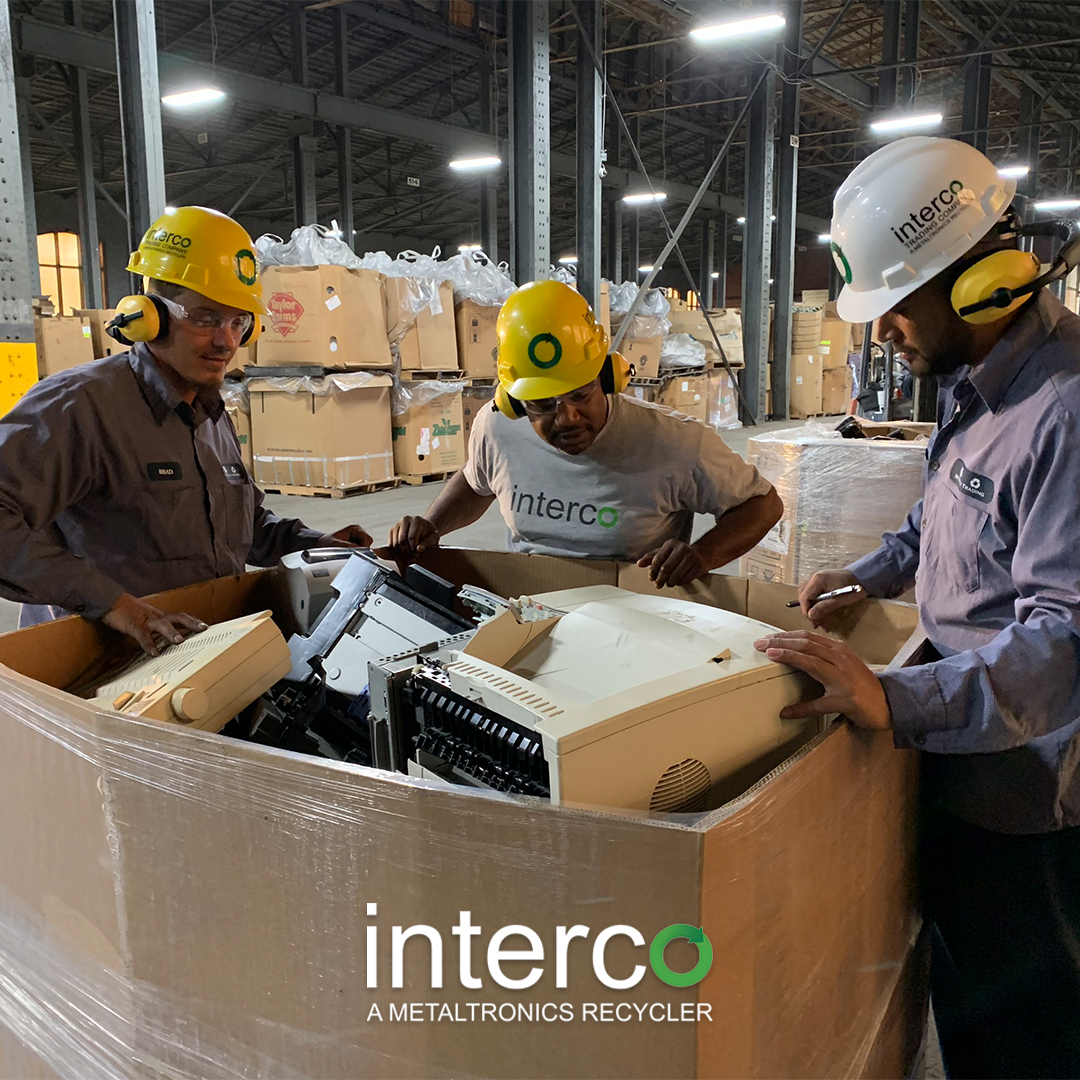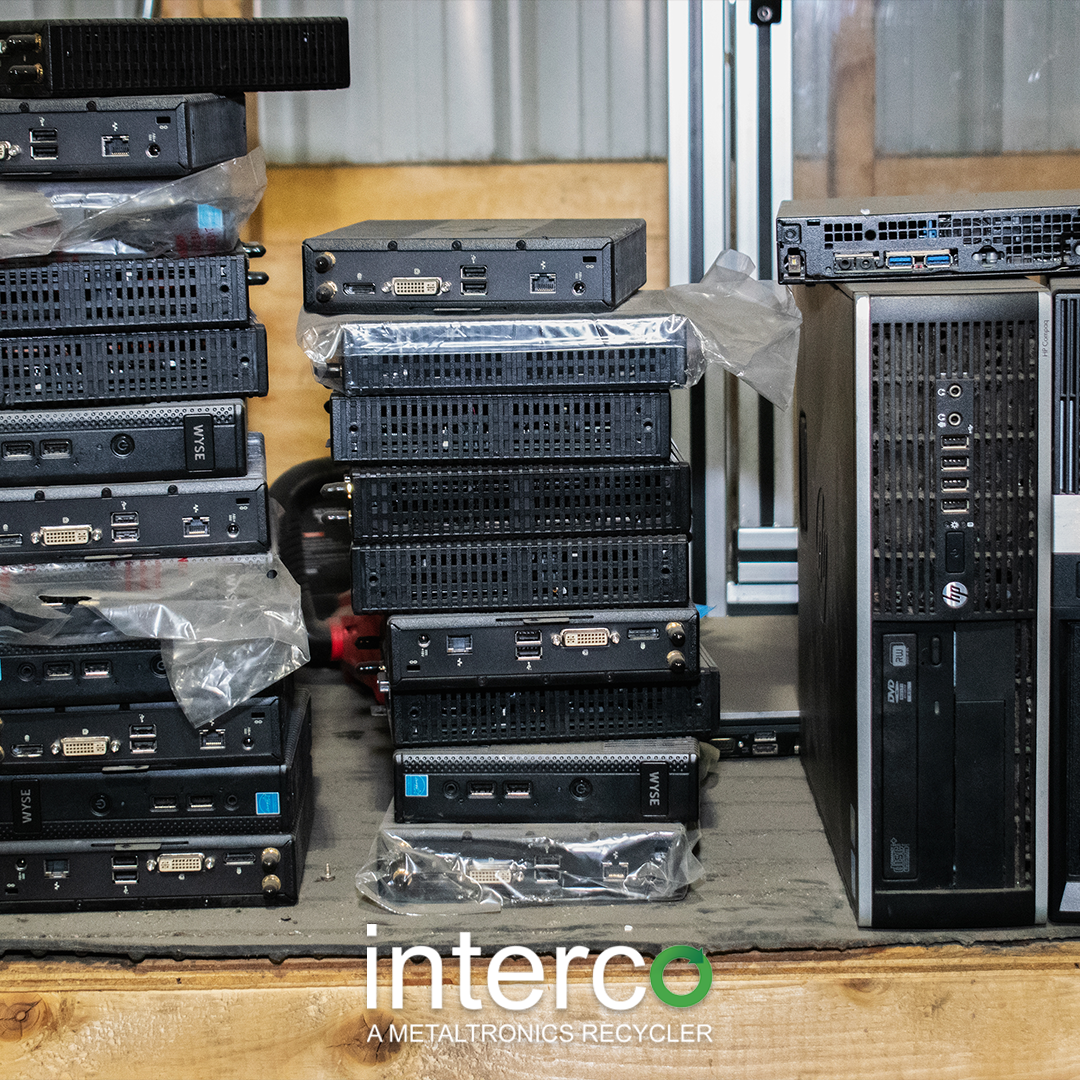Work from Home Spike Creates E-Waste Concerns
By Lea Rusk, Interco - A Metaltronics Recycler
Every company has data that they wish to protect. Regardless of its function most electronics store data in some way on a hard drive, USB flash drive, memory card, or other electronic sources. As consumers enter a new era of work, organizations nationwide are following a pandemic-led wave of remote work. E-waste contains an abundance of chemicals that are harmful to people and the environment, like mercury, lead, beryllium, brominated flame retardants, and cadmium. Electronics that are mishandled during disposal can eventually leak chemicals that end up in our soil, water, and air. Beyond the harmful health hazards, electronics and data security are top concerns when consumers replace their devices. The high volume of organizations purchasing new IT equipment has also produced data management concerns.

Many office workers and students have been forced to quickly create home offices so they can telecommute or complete their online studies. A record 53.6 million metric tons (Mt) of electronic waste was generated worldwide in 2019, up 21 percent in just five years, according to the UN’s Global E-waste Monitor 2020. With coronavirus cases continuing to spike and working from home seeming more and more permanent, it is vital that teams have the resources to stay consistent and effective in the way that they collaborate.

Computer monitors and other work-at-home essentials are in big demand. A new study, performed by data sanitization firm Blancco in partnership with business-to-business research firm Coleman Parkes, highlights the rise in e-waste during a global pandemic. The findings reveal that the pandemic forced almost half of the enterprises worldwide to shift their attention to end-of-life electronics challenges. E-waste is a common name for electronic products nearing the of their useful life. Computers, televisions, VCRs, stereos, copiers, and fax machines are common electronic products. According to the study, nearly all 600 enterprises surveyed (97%) had to purchase new laptops to accommodate the shift to remote working.
Blancco has released its new report, “The Rising Tide of E-Waste”, which shows the impacts the COVID-19 pandemic has had on electronic scrap. The study shows that 77 percent of American respondents say they also had to buy a new device to handle working from home more. The new era of work causes concerns from the couch. Employees working from home often have vulnerable servers creating opportunities for cybercrime to flourish. Blancco’s study showed that nearly 75 percent of respondents bought devices brand new to deal with the move from traditional offices to home office environments. The findings suggest that if data storage devices are not disposed of properly when they are decommissioned, thousands of usable and harvestable components can make their way into landfills – and can jeopardize data. The research showed that enterprises also purchased a total of 92 devices on average, which included tablets and smartphones.
Companies will face various challenges following the switch to remote working. The new work era demands organizations to consider the importance of using proper methods of data sanitization when new devices are eventually decommissioned. Purchasing new technology to enable employees’ transition to remote work during the pandemic has generated data security and e-scrap fears as businesses expand the volumes of devices they own and ultimately the amount of data that occupy them. Data sanitization is an important step in the e-waste lifecycle. Once data has reached the end of its life or is deemed obsolete, it is vital to dispose of the data securely. With an abundance of data scattered amongst a wide range of devices, data sanitization guarantees the data stored on a memory device is unrecoverable. A few methods of data sanitization destroy data to render the data beyond repair and achieve data sanitization.

Physical destruction is known as the process of shredding hard drives, smartphones, printers, laptops, and other storage media into tiny pieces by large mechanical shredders or using degaussers. With the same objective, cryptographic erasure acts as an appropriate method to achieve data sanitization. Cryptographic erasure is used interchangeably with Crypto Erase. The process of cryptographic erasure involves using encryption software (either built-in or deployed) on the entire data storage device, and erasing the key used to decrypt the data. Similarly, another method known as data erasure is the highest form of securing data with data sanitization. The validation process for data erasure ensures the data was successfully overwritten and offers auditable reporting. Data erasure is the software-based method of securely overwriting data from any data storage device using zeros and ones onto all sectors of the device. The risks caused by the coronavirus rise beyond public health and job security. Cyberthreats, including phishing scams and spam, are increasing as online criminals take advantage of remote workforces and corporate systems. The sudden surge in work-from-home employees increased the opportunity for cyberattacks as data is stored on a wide range of devices.
Amid the new challenges, the industry assesses current approaches to e-scrap management. Information Technology Asset Disposition (ITAD) as the management of decommissioning retired IT  assets further extends the value of electronics deemed obsolete. Most consumers and organizations often look forward to discarding their obsolete computers, monitors, and other electronic devices for newer, sleeker models. It is estimated that around 130 million mobile phones and 3 million tons of other electronic gadgets like televisions, laptops, and computers are retired annually. Although, an alternative disposal method includes ITAD which ensures data security and environmental compliance while extending residual value. Experts foresee a further 17% increase — to 52.2 million metric tons of e-waste by 2021 — the fastest-growing part of the world’s domestic waste stream, according to United Nations University.
assets further extends the value of electronics deemed obsolete. Most consumers and organizations often look forward to discarding their obsolete computers, monitors, and other electronic devices for newer, sleeker models. It is estimated that around 130 million mobile phones and 3 million tons of other electronic gadgets like televisions, laptops, and computers are retired annually. Although, an alternative disposal method includes ITAD which ensures data security and environmental compliance while extending residual value. Experts foresee a further 17% increase — to 52.2 million metric tons of e-waste by 2021 — the fastest-growing part of the world’s domestic waste stream, according to United Nations University.
The pandemic caused an unpredictable short-term investment in technology, which will leave organizations at risk with data being stored on a wide range of devices and an increase in electronic waste. Amid the COVID-19 crisis, the global market for IT Asset Disposition (ITAD) estimated at US$11. 6 Billion in the year 2020, is projected to reach a revised size of US$20. 7 Billion by 2027, growing at a CAGR of 8.6% over the analysis period 2020-2027. Enterprises can guarantee adequate processes are in place to ensure data security and the preservation of usable devices and components. When asked what will happen to their newly purchased devices when no longer required for remote work, 28 percent of enterprises said laptops would be erased to be resold. A further 27 percent said they would be erased to be reused internally. An additional 12 percent said they would be erased and recycled, and 9 percent will send them to an information technology asset disposition (ITAD) firm, according to the study. Organizations will face challenges following the transition to remote working, but the importance of using appropriate methods of data sanitization when new devices are eventually decommissioned remains vital.
Sources
 Lea Rusk
Lea RuskLea Rusk is a Digital Marketing Assistant at Interco. She graduated with a bachelor’s in Mass Communication: Multimedia Journalism in May 2020 from Southeast Missouri State University.